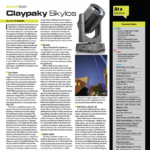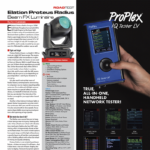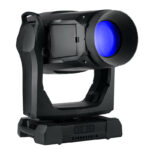While Robe might have been an unfamiliar (or distant) name a few years ago to many of us in the lighting industry, the company has seen strong success the past few years with its innovative and high-quality products. The company’s ROBIN LEDWash range and BMFL Spot have been highly successful, and now Robe ventures into the territory of LED strobes with the Strobe and Color Strobe. (Pronounced “strobe-ee”, like Robe.) An important caveat about this particular Road Test: all my tests were performed on a prototype fixture. “The paint is still drying,” as one Robe rep told me, so keep in mind that neither the hardware nor the software has been finalized, and it’s likely that the final shipping version will have some changes.
A Sturdy Build
The exterior of the unit is a very hardy shell indeed, with a lot of steel and aluminum used in its construction. Plastic handles let you loosen the rigging without tools to allow various angles to be used. On the top of each fixture are four recessed slots that correspond to four rigging points on the bottom of the fixture. These points slide into the rigging holes on top, and a level on the back of the fixture locks the two back points into place. This prevents them from sliding out, and the sturdy mechanism connects up to four lights together to create arrays. (The Color and white versions have identical rigging configurations.)
The fixture is quite heavy — 27.6 pounds (12.5 kg) with the rigging hardware. Addressing and mode adjustments are done using the now-familiar Robe control interface on the rear of the fixture — a touchscreen for navigating the menu system. Robe has clearly put a lot of thought into this menu system — things like the slider to adjust the DMX address continue to show that they care about the people setting up their lights, which I appreciate. The display also has buttons that can be used in case you don’t want to use the touchscreen, or if the touch capability were to fail.
On the face of the fixture are 120 28W RGBW LED packages — Robe calls them “chips” — arranged in a grid. These can be addressed as one block, as a group of four equal squares across the face, or as a four-by-three grid of 12 total pixels (what Robe calls “zones”) by selecting the appropriate mode. The LED packages are topped with a TIR reflector and have a slight frosted surface to them to help homogenize the output. These do a good job, and I saw no multicolored shadows at normal throw distances. The beam angle is 63° at full output, as expected from a strobe light.
The various modes offer different feature sets, depending on your needs. The first two modes allow control of the entire face of the fixture as one block, in either 8- or 16-bit control of color and intensity, respectively. Modes four and five are the pixel-mapping modes. They break up the face of the fixture into the aforementioned four or 12 pixels or zones, and are mainly for eye candy effects. In this mode, while each pixel has two strobe channels, it’s for a straight strobe effect only, meaning the user can only select a rate and duration for the flash. Mode three is the only mode that allows access to common strobe functions like random strobe, ramps, lightning effects and spikes, so users will need to build these effects in the console when running in other modes. This is an interesting choice by Robe —I feel the fixture would be more versatile if this functionality were included for every zone in modes four and five for increased control, despite the increased channel count. Mode three also allows the user to overlay flashes of color; by setting a foreground and background color on the fixture, you can create some very cool effects that would be time-consuming or difficult to program with effects or chases. There’s also a macro/effects channel in this mode. It gives you access to some very cool chases and patterns across the front of the fixture, letting you use the pixels without needing to fully pixel-map the light.
Brightness and Dimming
The fixture is very bright — I measured 3,580 lux at 5 meters at initial power-on, which is actually a little higher than their published photometric data. I read 2,800 lux after 30 minutes of continuous runtime, a drop of 22 percent. Users who plan to use this fixture as a strobe only will be unlikely to see any thermal drop, and should get the full intensity every time the light fires. Robe tells me that, for flashes, the power supply overdrives the LEDs somewhat to achieve even more brightness.
The dimming is reasonably smooth for an effect light like this. I noticed that the LEDs pop on when you hit one percent on the console; however, it’s obviously smoothed on both fade-in and fadeouts. The LEDs never just snap to their level when running at low levels or doing slow fades. Robe is clearly smoothing and interpolating the incoming DMX data, which helps to avoid some of that jitteriness and stepping that earlier LED products had. Of course, the LEDs snap to full brightness when told to without delay, as any strobe should. The fixture includes both linear and square law dimmer settings in the menu options. The PWM frequency is 14,400Hz when in full RGBW, and this drops to 3,600Hz when using single colors, which should be fast enough to prevent any issues with cameras that use rolling shutters.
The colors are quite saturated, as the company has gone with full, deep colors to aid in its dual role as a washlight — the blue here is the very deep royal blue shade. I measured the output of all the colors individually at full, which added up to more than 100 percent, indicating some load sharing among emitters. Robe includes a CTC channel for color temperature control, and at the 2,700K or 3,200K setting includes fake thermal delay and redshift, just like a tungsten lamp.
Going the Extra Mile
The fixture accepts 90-240V input voltage via the soon-to-be-industry-standard Neutrik True1 ins and throughs, and is completely auto-ranging. Robe claims the light pulls 660 watts at full blast which, when running on 208V, allows you to safely string up to 12 of them together on a single 20 amp circuit — certainly a far cry from the days of powerful xenon strobes that each needed their own circuit. The rear of fixture is protected from the elements with a rear dust cover for the sensitive menu display, and the DMX ins and throughs are on two short tails that terminate to 5-pin XLR connectors. There are also an Ethernet in and through for data. Robe has gone the extra mile in terms of protocol support, and the fixture supports Art-Net, MA-Net versions 1 and 2, sACN, and, of course RDM.



